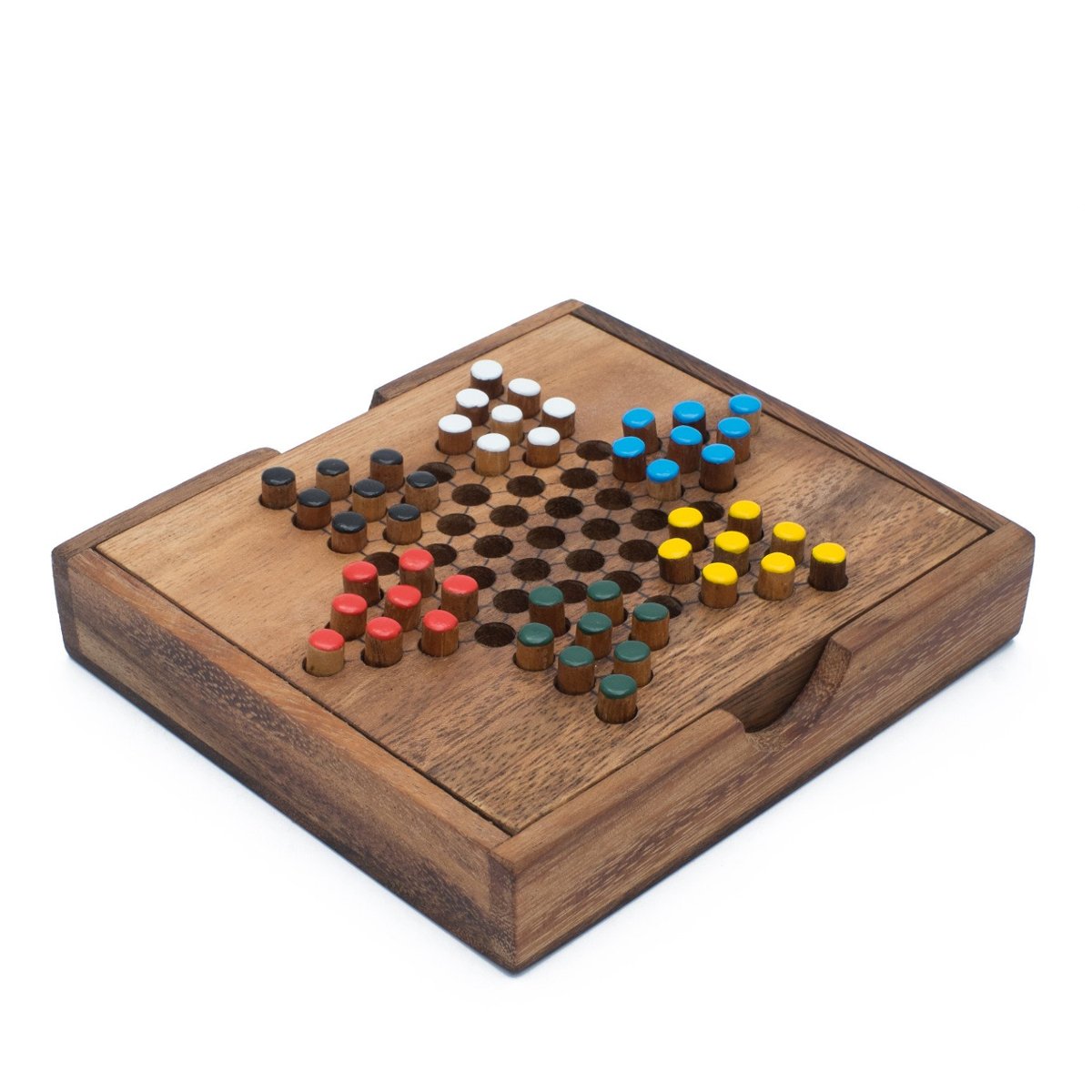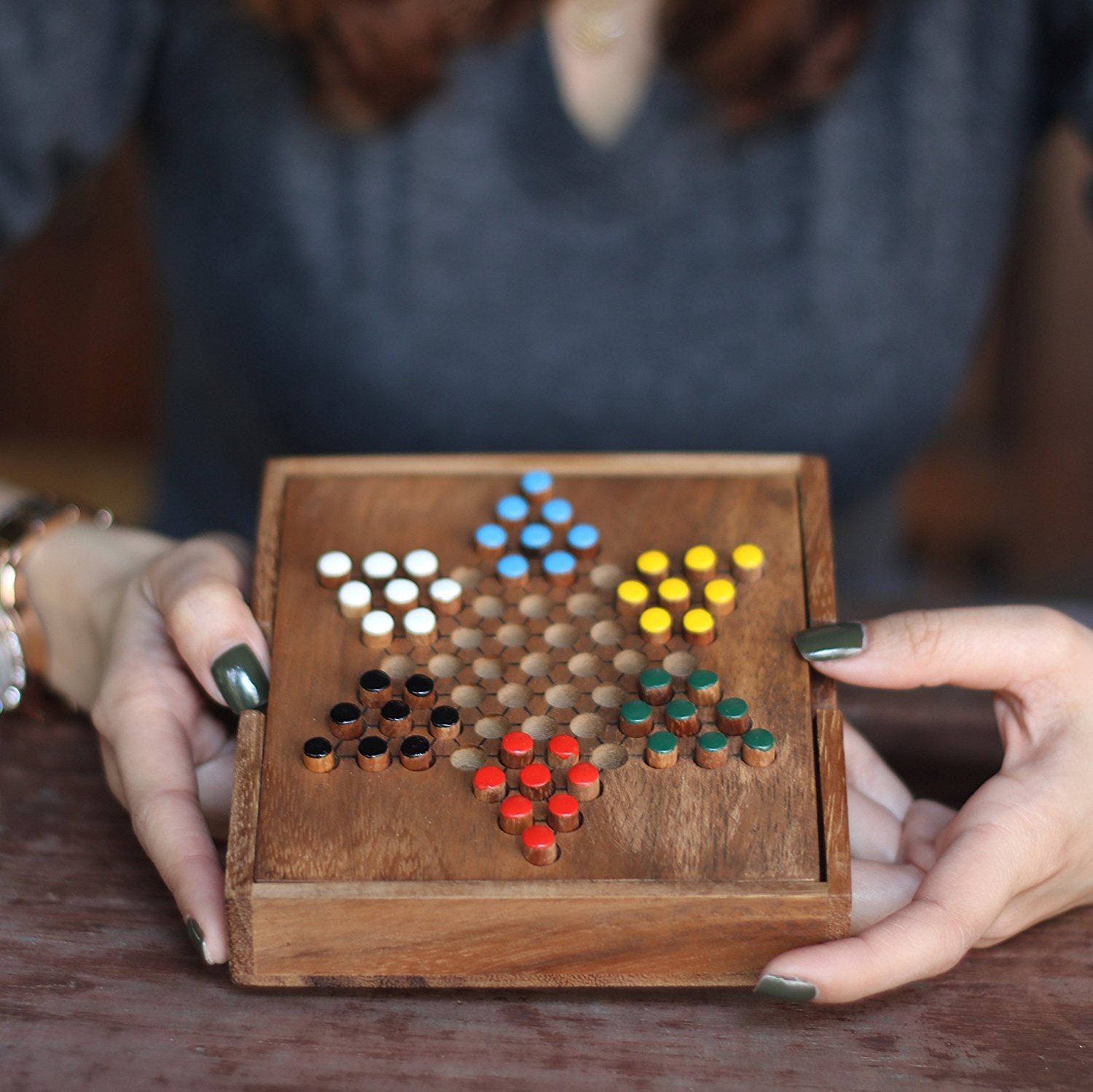
Chinese checkers is a timeless game that’s played all around the world by people of every age. Despite what its name might indicate, the game actually originated in Germany, during the late 19th century. It’s a straightforward game with simple rules, but it also has the potential for complex strategic maneuvers. If you’ve clicked on this blog post then you probably already know how to play, and are just here looking for a few tips, tricks, or advice to help take your game to the next level. If that’s you – then you came to the right place. If you aren’t already familiar with how to play and still need an introduction, check out our previous blog post here that outlines how to play as well as some basic rules and tactics to help get you started.
Efficiency in the Early Game
When it comes to Chinese checkers, the name of the game is efficiency. The number of players may vary, but you will always have at least one opponent – engaging with, or blocking them is important – but in order to win, the only requirement is moving all your pieces to the opposite side of the board. With that being said, maintaining efficiency out of the gate is crucial to beating your opponent and moving all your pieces to their final destination in the least amount of turns possible.
There are two main strategies when it comes to opening moves and setting up your pieces for success. Both maneuvers exercise a similar line of thinking, with the intent to get your pieces ready to be jumped like a ladder. Setting up your board in this manner early allows more of your pieces to jump over each other, moving each piece more and more spaces every time. This gets all your pieces in play and out of their starting positions faster than other methods. The optimal way to begin the game is by moving pieces from the edges of your front row towards the center of the board like pictured below. This move allows you to be more effective in initiating your attack thanks to the subsequent jumps that be set up from this position.
Control the Center of the Board
An added benefit of using this opening strategy is that it increases your presence in and around the center of the board. Beginning in this way provides opportunities to jump your early pieces over each other, populating the middle of the board earlier than your opponent. Maintaining control over the center of the board serves a multitude of purposes. Not only is it effective in getting your pieces in play and nearing them toward your goal, but it also serves to hinder your opponent’s progress at the same time.
Keeping your pieces based around the center of the board can help to serve as a launchpad allowing you to jump multiple times in lots of different directions. When your pieces are centered in one compact location like this, it also improves your pieces’ movements. Your pieces are nearby to each other and can play off each other. Whether it’s for jumping, blocking, or advancing, keeping your pieces around the middle of the board gives you lots of options and opportunities to win while also playing a bit of defense.
Make Use of Jumping
In case you haven’t already noticed, one of the most important skills to master in Chinese Checkers is jumping. Being able to effectively jump over other pieces more than doubles your movement speed and allows you to make the most out of every turn. Even if you aren’t jumping over a piece on one turn, it’s important to keep future potential jumps in mind and always be setting up for a bigger move.
Keep the rules in mind when playing, and remember you are able to jump over any piece of any color, not only your own! You can jump over any combination of pieces in any direction in the same turn, only if each jump happens in a straight line. It is also permissible to move your pieces backwards, forwards and sideways one spot, or jumping to go two. Double jumps (and more) are allowed and can even be strung together with changes of direction in the middle.
Making use of your jumps is particularly beneficial towards the end of the game. One of the best tips we can offer is that when you are transporting your pieces across the board and moving them into the opposite corner, only fill in every other row. This way, as you continue towards victory and keep populating your goal area, you can jump over your own pieces to finish, saving several moves in the process.
Blocking your Opponent(s)
Although the objective of the game doesn’t necessarily require engaging with your opponent, interacting with them and their pieces is a key component to coming out of the game victorious. Remember that you can block your opponent’s pieces either by occupying a space adjacent to them that they are trying to move into, or by taking a space somewhere else where they were planning on jumping to in the future. It is much easier and more effective to block your opponent when you have strong control over the middle of the board since it is so much easier to reach potential points of interest.
Trying to block your opponent is not easy though, especially due to the fact that they are able to jump over your pieces if there is a free space on the other side. This is why it is important to play the psychological game as well. Knowing where the other players are trying to go and what they are trying to achieve allows you to beat them to the spots that they are trying to reach. Cutting them off and forcing them to take a longer route just might provide the delay you need to beat them.
Technically, it is possible to occupy your opponent’s goal spaces indefinitely, which physically prevents them from winning the game. The downside to this is that your pieces are needed in order to do so, so in reality the game would just be a stalemate ending only once you decide to move. This technique is generally considered unsportsmanlike and is not very popular as it prevents the game from continuing as intended. Some rulebooks ban this practice outright, although in more competitive situations it can be beneficial in moments. It is always better to discuss with your group beforehand whether this tactic is permissible in your game.
Playing with 4-6 Players
Being able to effectively block your opponent takes lots of skill and practice. Like we mentioned before, it is difficult to make clever use of your pieces as blockades, while also keeping them together with the rest of your pieces. This is especially difficult the more players there are. Consider a game with six players, it is far more difficult to keep track of every players’ pieces and intentions. With six players it is much harder to anticipate where your opponents need to be and then trying to beat them there. It is also harder to maneuver around the board in general due to the total number of pieces in play.
You will also have to pay extra attention to your own pieces, to ensure none of the other players are trying to make any moves against you as you move for your goal. The moves and jumps you try to set up will be foiled more easily, and it will be harder for you to organize blockades against your opponents. In a game of 4 or 6 players, there are just so many more pieces in play, and you have so much less control and influence over the board that it is often more beneficial to focus on advancing your own pieces rather than worrying about everyone else’s. Conversely, in games with 1-3 players, there is a lot more to be gained from trying to sabotage the movements of the other players due to the decreased risk.
Don’t Let Any of Your Pieces Fall Behind
Keeping your pieces in a general, loosely constructed group is beneficial because your pieces will be less likely to get blocked, or trapped around the sides of the board. If your pieces are split into smaller groups, this is okay, but it is important not to leave one piece behind on its own. Straggling pegs or marbles can take many moves to catch up with the rest of your pieces. Without any other pieces to jump over and ladder, it takes too many turns to get your pieces back together which can result in an early loss. This is why attempting traps and blocks in larger games is so risky, your pieces can get stuck behind and take too long to recover and rejoin with the group.
One way that pieces often get left behind is when they are trapped by an opponent. This is often done around the sides and corners of the board. The sidelines are like an extra defender or opponent who can block an entire side. Along the side of the board your movement and jump options are severely limited. Be very mindful when you have pieces near the sides of the board, as they can be easily trapped. Likewise, keep an eye on your opponent’s pieces that are nearby to edges. If the opportunity presents itself, it is easy to trap one of their pieces, and it will be good for your chances to win if the opponent has pieces straggling behind. When in this position, utilize your network of your pieces to cover more ground and compound the lead that you have. Upon finally releasing the opponent’s piece, it should take them too many turns to recover.
The Psychological Game
Due to its straightforward rules, simple concepts, and generally unambiguous strategy, much of the nuance surrounding Chinese Checkers comes from the psychological and mental games that go along with it. If you are competing against other experienced players, they will likely be trying to implement all the same tactics as you: controlling the center of the board, setting up to chain jumps together, and even trying to trap or block when possible. In these instances, the best way to separate yourself from other experienced players is in the mental aspect of the game.
Although some of the best practices for the game have been discovered and are readily available, when playing against experienced players it may be necessary to use them deceptively. When playing against seasoned players, rather than simply going in and trying to set up for all the tips and strategy mentioned above, try bluffing or misleading the opponent. Make them believe you are planning and setting up for one thing before executing and following through with another, it just might give you the edge you need to win. Perhaps it means drawing their focus or their pieces towards one of your own in order to trap them, or blocking them in a particular way they didn’t see coming; the important part is to subvert expectations and catch them off guard.
This is where the straightforward strategy and tactics get complicated. Maybe it means purposefully setting up your pieces to be jumped by the enemy, only to lead them to a corner where you can block or trap them. Get creative and have fun trying to play against the opponent rather than their pieces.
Common Mistakes
Mistakes in Chinese Checkers most often come from the overzealous application of some of the common best practices and strategies. Some of the most common errors are related to blocking, defense, and strategy. When blocking, it is extremely important to consider the state of the game in that moment. Broadly, blocking is a good idea. But sometimes later in the game, trying too hard to block an opponent may lead to you overextending your pieces. To the point that you may not be able to get them to the goal in time as you’ll have to retrace all the steps you took trying to get there and block. Blocking is most effective and beneficial for you when done earlier in the game. The longer the game goes on, the less beneficial blocking will be.
In games where there is an opponent whose goal triangle is the same as your starting one, strategically blocking or defending this territory for some time has a positive impact on your odds to win. It is important to build out a network of pieces simultaneously, so that after blocking, you can still move all your pieces efficiently. Newer players often try to evacuate their starting spaces as soon as possible, even though this is not always the best choice. Controlling the center of the board and getting your pieces in play is important, but it’s not everything.
Regarding strategy, the most common mistake is a failure to adapt to the changing circumstances of the game. None of these tips or tricks are a prescription, they are just guidelines to inform the best ways to play in a vacuum. The best strategy in one game against one opponent may not work as well in another match against someone else. Every opponent is unique, and every single game is different. Being able to watch the game unfold and adapt by implementing these strategies accordingly is one of the most important factors to consistently win at Chinese Checkers.
Closing
Before making any move in Chinese checkers there are so many things to consider. What your goal is, what kind of jumps you are planning, where your opponent’s pieces are, if there are any pieces falling behind, and so on. You should be planning your own future moves, while also monitoring and trying to predict your opponents’. Putting all this information together and into practice is difficult. It takes many games to start getting the hang of it before you will start to see some real improvement. The best way to win at Chinese checkers is a healthy combination of all the previous information mentioned above. Chinese checkers is a strategy game where the best way to beat someone is by outthinking and outmaneuvering them on the board. Although Chinese checkers might traditionally be thought of as an easier game to master than chess, it is still a game with lots of subtleties that make it an intellectually stimulating and worthwhile endeavor.



